Performance Evaluation of MQCL Hard Milling of SKD 11 Tool Steel Using MoS2 Nanofluid
Abstract
1. Introduction
2. Material and Methods
2.1. Experimental Set Up
2.2. The Preparation of MoS2 Nanofluid
2.3. Experiment Design
3. Results and Discussion
3.1. The Effects of Input Machining Parameters on Surface Roughness
3.2. The Optimized and Validated Experiments
3.2.1. The Effects of Cooling and Lubricating on Surface Quality
3.2.2. The Effect of MoS2 Nanoparticle Concentration on Surface Roughness
3.2.3. The Effect of MQCL Technique Using MoS2 Nanofluid on Cutting Performance
4. Conclusions
Author Contributions
Funding
Acknowledgments
Conflicts of Interest
Appendix A
| 1 Std Order | Run Order | 2 Pt Type | Blocks | Input Machining Parameters | Response Variable | ||
|---|---|---|---|---|---|---|---|
| X1 | X2 | X3 | Ra | ||||
| 1 | 20 | 2 | 1 | 0.5 | 90 | 56 | 0.115 |
| 2 | 30 | 2 | 1 | 1.5 | 90 | 56 | 0.139 |
| 3 | 7 | 2 | 1 | 0.5 | 110 | 56 | 0.127 |
| 4 | 41 | 2 | 1 | 1.5 | 110 | 56 | 0.118 |
| 5 | 4 | 2 | 1 | 0.5 | 100 | 52 | 0.201 |
| 6 | 39 | 2 | 1 | 1.5 | 100 | 52 | 0.257 |
| 7 | 32 | 2 | 1 | 0.5 | 100 | 60 | 0.189 |
| 8 | 14 | 2 | 1 | 1.5 | 100 | 60 | 0.212 |
| 9 | 16 | 2 | 1 | 1 | 90 | 52 | 0.202 |
| 10 | 29 | 2 | 1 | 1 | 110 | 52 | 0.161 |
| 11 | 22 | 2 | 1 | 1 | 90 | 60 | 0.214 |
| 12 | 18 | 2 | 1 | 1 | 110 | 60 | 0.194 |
| 13 | 23 | 0 | 1 | 1 | 100 | 56 | 0.116 |
| 14 | 43 | 0 | 1 | 1 | 100 | 56 | 0.131 |
| 15 | 19 | 0 | 1 | 1 | 100 | 56 | 0.139 |
| 16 | 11 | 2 | 1 | 0.5 | 90 | 56 | 0.092 |
| 17 | 21 | 2 | 1 | 1.5 | 90 | 56 | 0.179 |
| 18 | 13 | 2 | 1 | 0.5 | 110 | 56 | 0.141 |
| 19 | 37 | 2 | 1 | 1.5 | 110 | 56 | 0.109 |
| 20 | 38 | 2 | 1 | 0.5 | 100 | 52 | 0.112 |
| 21 | 33 | 2 | 1 | 1.5 | 100 | 52 | 0.187 |
| 22 | 12 | 2 | 1 | 0.5 | 100 | 60 | 0.111 |
| 23 | 9 | 2 | 1 | 1.5 | 100 | 60 | 0.124 |
| 24 | 28 | 2 | 1 | 1 | 90 | 52 | 0.189 |
| 25 | 45 | 2 | 1 | 1 | 110 | 52 | 0.207 |
| 26 | 10 | 2 | 1 | 1 | 90 | 60 | 0.196 |
| 27 | 2 | 2 | 1 | 1 | 110 | 60 | 0.184 |
| 28 | 15 | 0 | 1 | 1 | 100 | 56 | 0.151 |
| 29 | 36 | 0 | 1 | 1 | 100 | 56 | 0.138 |
| 30 | 27 | 0 | 1 | 1 | 100 | 56 | 0.229 |
| 31 | 6 | 2 | 1 | 0.5 | 90 | 56 | 0.112 |
| 32 | 17 | 2 | 1 | 1.5 | 90 | 56 | 0.102 |
| 33 | 5 | 2 | 1 | 0.5 | 110 | 56 | 0.101 |
| 34 | 3 | 2 | 1 | 1.5 | 110 | 56 | 0.162 |
| 35 | 35 | 2 | 1 | 0.5 | 100 | 52 | 0.138 |
| 36 | 25 | 2 | 1 | 1.5 | 100 | 52 | 0.165 |
| 37 | 42 | 2 | 1 | 0.5 | 100 | 60 | 0.121 |
| 38 | 1 | 2 | 1 | 1.5 | 100 | 60 | 0.118 |
| 39 | 31 | 2 | 1 | 1 | 90 | 52 | 0.201 |
| 40 | 26 | 2 | 1 | 1 | 110 | 52 | 0.192 |
| 41 | 8 | 2 | 1 | 1 | 90 | 60 | 0.175 |
| 42 | 40 | 2 | 1 | 1 | 110 | 60 | 0.126 |
| 43 | 44 | 0 | 1 | 1 | 100 | 56 | 0.141 |
| 44 | 24 | 0 | 1 | 1 | 100 | 56 | 0.172 |
| 45 | 34 | 0 | 1 | 1 | 100 | 56 | 0.185 |
| Source | DF | Adj SS | Adj MS | F-Value | p-Value |
|---|---|---|---|---|---|
| Model | 6 | 0.030316 | 0.005053 | 4.63 | <0.001 |
| Linear | 3 | 0.006987 | 0.002329 | 2.14 | 0.112 |
| X1 | 1 | 0.004056 | 0.004056 | 3.72 | 0.061 |
| X2 | 1 | 0.000368 | 0.000368 | 0.34 | 0.565 |
| X3 | 1 | 0.002563 | 0.002563 | 2.35 | 0.134 |
| Square | 3 | 0.023329 | 0.007776 | 7.13 | <0.001 |
| X1*X1 | 1 | 0.008849 | 0.008849 | 8.12 | <0.007 |
| X2*X2 | 1 | 0.000085 | 0.000085 | 0.08 | 0.782 |
| X3*X3 | 1 | 0.012607 | 0.012607 | 11.56 | <0.002 |
| Error | 38 | 0.041433 | 0.001090 | - | - |
| Lack-of-Fit | 6 | 0.003599 | 0.000600 | 0.51 | 0.798 |
| Pure Error | 32 | 0.037834 | 0.001182 | - | - |
| Total | 44 | 0.071750 | - | - | - |
References
- Davim, J.P. Machining of Hard Materials; Springer: London, UK, 2011. [Google Scholar]
- Bouacha, K.; Yallese, M.A.; Mabrouki, T.; Rigal, J.-F. Statistical analysis of surface roughness and cutting forces using response surface methodology in hard turning of AISI 52100 bearing steel with CBN tool. Int. J. Refract. Met. Hard Mater. 2010, 28, 349–361. [Google Scholar] [CrossRef]
- Zhang, K.; Deng, J.; Meng, R.; Gao, P.; Yue, H. Effect of nano-scale textures on cutting performance of WC/Co-based Ti55Al45N coated tools in dry cutting. Int. J. Refract. Met. Hard Mater. 2015, 51, 35–49. [Google Scholar] [CrossRef]
- Liu, Y.; Deng, J.; Wang, W.; Duan, R.; Meng, R.; Ge, D.; Li, X. Effect of texture parameters on cutting performance of flank-faced textured carbide tools in dry cutting of green Al2O3 ceramics. Ceram. Int. 2018, 44, 13205–13217. [Google Scholar] [CrossRef]
- Kumar, C.S.; Patel, S.K. Effect of WEDM surface texturing on Al2O3/TiCN composite ceramic tools in dry cutting of hardened steel. Ceram. Int. 2018, 44, 2510–2523. [Google Scholar] [CrossRef]
- Xing, Y.; Deng, J.; Zhao, J.; Zhang, G.; Zhang, K. Cutting performance and wear mechanism of nanoscale and microscale textured Al2O3/TiC ceramic tools in dry cutting of hardened steel. Int. J. Refract. Met. Hard Mater. 2014, 43, 46–58. [Google Scholar] [CrossRef]
- Su, Y.; Li, Z.; Li, L.; Wang, J.; Gao, H.; Wang, G. Cutting performance of micro-textured polycrystalline diamond tool in dry cutting. J. Manuf. Process. 2017, 27, 1–7. [Google Scholar] [CrossRef]
- Rahim, E.A.; Dorairaju, H. Evaluation of mist flow characteristic and performance in Minimum Quantity Lubrication (MQL) machining. Measurement 2018, 123, 213–225. [Google Scholar] [CrossRef]
- Abdul Sani, A.S.; Rahim, E.A.; Sharif, S.; Sasahara, H. Machining performance of vegetable oil with phosphonium- and ammonium-based ionic liquids via MQL technique. J. Clean. Prod. 2019, 209, 947–964. [Google Scholar] [CrossRef]
- Joshi, K.K.; Kumar, R.; Anurag. An Experimental Investigations in Turning of Incoloy 800 in Dry, MQL and Flood Cooling Conditions. Procedia Manuf. 2018, 20, 350–357. [Google Scholar] [CrossRef]
- Tunc, L.T.; Gu, Y.; Burke, M.G. Effects of Minimal Quantity Lubrication (MQL) on Surface Integrity in Robotic Milling of Austenitic Stainless Steel. Procedia CIRP 2016, 45, 215–218. [Google Scholar] [CrossRef]
- Duc, T.M.; Long, T.T. Investigation of MQL-Employed Hard-Milling Process of S60C Steel Using Coated-Cemented Carbide Tools. J. Mech. Eng. Autom. 2016, 6, 128–132. [Google Scholar]
- Kang, M.; Kim, K.; Shin, S.; Jang, S.; Park, J.; Kim, C. Effect of the minimum quantity lubrication in high-speed end-milling of AISI D2 cold-worked die steel (62 HRC) by coated carbide tools. Surf. Coat. Technol. 2008, 202, 5621–5624. [Google Scholar] [CrossRef]
- Davim, J.P.; Sreejith, P.S.; Silva, J. Turning of Brasses Using Minimum Quantity of Lubricant (MQL) and Flooded Lubricant Conditions. Mater. Manuf. Process. 2007, 22, 45–50. [Google Scholar] [CrossRef]
- Davim, J.P.; Sreejith, P.S.; Gomes, R.; Peixoto, C. Experimental studies on drilling of aluminium (AA1050) under dry, minimum quantity of lubricant, and flood-lubricated conditions. Proc. Inst. Mech. Eng. Part B J. Eng. Manuf. 2006, 220, 1605–1611. [Google Scholar] [CrossRef]
- Gaitonde, V.N.; Karnik, S.R.; Davim, J.P.; Gaitonde, V. Optimal MQL and Cutting Conditions Determination for Desired Surface Roughness in Turning of Brass Using Genetic Algorithms. Mach. Sci. Technol. 2012, 16, 304–320. [Google Scholar] [CrossRef]
- Carou, D.; Rubio, E.M.; Davim, J.P. A note on the use of the minimum quantity lubrication (MQL) system in turning. Ind. Lubr. Tribol. 2015, 67, 256–261. [Google Scholar] [CrossRef]
- Carou, D.; Rubio, E.; Lauro, C.; Davim, J.P.; Porto, D.C.; Lauro, C. The effect of minimum quantity lubrication in the intermittent turning of magnesium based on vibration signals. Measurement 2016, 94, 338–343. [Google Scholar] [CrossRef]
- Gupta, K.; Laubscher, R.; Davim, J.P.; Jain, N.K. Recent developments in sustainable manufacturing of gears: A review. J. Clean. Prod. 2016, 112, 3320–3330. [Google Scholar] [CrossRef]
- Davim, J.P. (Ed.) Sustainable Manufacturing; ISTE Ltd.: London, UK; John Wiley & Sons, Inc.: Hoboken, NJ, USA, 2010; ISBN 978-1-84821-212-1. [Google Scholar]
- Davim, J.P. (Ed.) Green Manufacturing Processes and Systems; Materials Forming, Machining and Tribology; Springer: Berlin/Heidelberg, Germany, 2013. [Google Scholar]
- Minh, D.T.; The, L.T.; Bao, N.T. Performance of Al2O3 nanofluids in minimum quantity lubrication in hard milling of 60Si2Mn steel using cemented carbide tools. Adv. Mech. Eng. 2017, 9, 1–9. [Google Scholar] [CrossRef]
- Long, T.T.; Duc, T.M. Micro/Nanofluids in Sustainable Machining. In Microfluidics and Nanofluidics; IntechOpen: London, UK, 2018. [Google Scholar]
- Li, B.; Li, C.; Zhang, Y.; Wang, Y.; Jia, D.; Yang, M.; Zhang, N.; Wu, Q.; Han, Z.; Sun, K. Heat transfer performance of MQL grinding with different nanofluids for Ni-based alloys using vegetable oil. J. Clean. Prod. 2017, 154, 1–11. [Google Scholar] [CrossRef]
- Lee, P.-H.; Nam, J.S.; Li, C.; Lee, S.W. An experimental study on micro-grinding process with nanofluid minimum quantity lubrication (MQL). Int. J. Precis. Eng. Manuf. 2012, 13, 331–338. [Google Scholar] [CrossRef]
- Ali, M.K.A.; Hou, X.; Mai, L.; Cai, Q.; Turkson, R.F.; Chen, B. Improving the tribological characteristics of piston ring assembly in automotive engines using Al2O3 and TiO2 nanomaterials as nano-lubricant additives. Tribol. Int. 2016, 103, 540–554. [Google Scholar] [CrossRef]
- Pashmforoush, F.; Bagherinia, R.D. Influence of water-based copper nanofluid on wheel loading and surface roughness during grinding of Inconel 738 superalloy. J. Clean. Prod. 2018, 178, 363–372. [Google Scholar] [CrossRef]
- Uysal, A.; Demiren, F.; Altan, E. Applying Minimum Quantity Lubrication (MQL) Method on Milling of Martensitic Stainless Steel by Using Nano MoS2 Reinforced Vegetable Cutting Fluid. Procedia Soc. Behav. Sci. 2015, 195, 2742–2747. [Google Scholar] [CrossRef]
- Zhang, Y.; Li, C.; Jia, D.; Li, B.; Wang, Y.; Yang, M.; Hou, Y.; Zhang, X. Experimental study on the effect of nanoparticle concentration on the lubricating property of nanofluids for MQL grinding of Ni-based alloy. J. Mater. Process. Technol. 2016, 232, 100–115. [Google Scholar] [CrossRef]
- Yıldırım, Ç.V.; Sarıkaya, M.; Kıvak, T.; Şirin, Ş. The effect of addition of hBN nanoparticles to nanofluid-MQL on tool wear patterns, tool life, roughness and temperature in turning of Ni-based Inconel 625. Tribol. Int. 2019, 134, 443–456. [Google Scholar] [CrossRef]
- Garg, A.; Sarma, S.; Panda, B.; Zhang, J.; Gao, L. Study of effect of nanofluid concentration on response characteristics of machining process for cleaner production. J. Clean. Prod. 2016, 135, 476–489. [Google Scholar] [CrossRef]
- Lee, G.-J.; Park, J.-J.; Lee, M.-K.; Rhee, C.K. Stable dispersion of nanodiamonds in oil and their tribological properties as lubricant additives. Appl. Surf. Sci. 2017, 415, 24–27. [Google Scholar] [CrossRef]
- Wang, Y.; Li, C.; Zhang, Y.; Li, B.; Yang, M.; Zhang, X.; Guo, S.; Liu, G. Experimental evaluation of the lubrication properties of the wheel/workpiece interface in MQL grinding with different nanofluids. Tribol. Int. 2016, 99, 198–210. [Google Scholar] [CrossRef]
- Luo, T.; Wei, X.; Huang, X.; Huang, L.; Yang, F. Tribological properties of Al2O3 nanoparticles as lubricating oil additives. Ceram. Int. 2014, 40, 7143–7149. [Google Scholar] [CrossRef]
- Pervaiz, S.; Deiab, I.; Rashid, A.; Nicolescu, M. Minimal quantity cooling lubrication in turning of Ti6Al4V: Influence on surface roughness, cutting force and tool wear. Proc. Inst. Mech. Eng. Part B J. Eng. Manuf. 2017, 231, 1542–1558. [Google Scholar] [CrossRef]
- Maruda, R.W.; Krolczyk, G.M.; Feldshtein, E.; Nieslony, P.; Tyliszczak, B.; Pusavec, F. Tool wear characterizations in finish turning of AISI 1045 carbon steel for MQCL conditions. Wear 2017, 372, 54–67. [Google Scholar] [CrossRef]
- Maruda, R.W.; Krolczyk, G.M.; Feldshtein, E.; Pusavec, F.; Szydlowski, M.; Legutko, S.; Sobczak-Kupiec, A. A study on droplets sizes, their distribution and heat exchange for minimum quantity cooling lubrication (MQCL). Int. J. Mach. Tools Manuf. 2016, 100, 81–92. [Google Scholar] [CrossRef]
- Maruda, R.W.; Krolczyk, G.M.; Wojciechowski, S.; Zak, K.; Habrat, W.; Nieslony, P. Effects of extreme pressure and anti-wear additives on surface topography and tool wear during MQCL turning of AISI 1045 steel. J. Mech. Sci. Technol. 2018, 32, 1585–1591. [Google Scholar] [CrossRef]
- Maruda, R.; Krolczyk, G.; Niesłony, P.; Krolczyk, J.; Legutko, S.; Krolczyk, G. Chip Formation Zone Analysis During the Turning of Austenitic Stainless Steel 316L under MQCL Cooling Condition. Procedia Eng. 2016, 149, 297–304. [Google Scholar] [CrossRef]
- Krolczyk, G.; Maruda, R.; Krolczyk, J.; Nieslony, P.; Wojciechowski, S.; Legutko, S. Parametric and nonparametric description of the surface topography in the dry and MQCL cutting conditions. Measurement 2018, 121, 225–239. [Google Scholar] [CrossRef]
- Maruda, R.W.; Feldshtein, E.; Legutko, S.; Krolczyk, G.M. Research on emulsion mist generation in the conditions of minimum quantity cooling lubrication (MQCL). Teh. Vjesn. Tech. Gaz. 2015, 22, 1213–1218. [Google Scholar]
- Gutnichenko, O.; Bushlya, V.; Bihagen, S.; Ståhl, J.-E. Influence of graphite nanoadditives to vegetable-based oil on machining performance when MQCL assisted hard turning. Procedia CIRP 2018, 77, 437–440. [Google Scholar] [CrossRef]
- Sartori, S.; Ghiotti, A.; Bruschi, S. Temperature effects on the Ti6Al4V machinability using cooled gaseous nitrogen in semi-finishing turning. J. Manuf. Process. 2017, 30, 187–194. [Google Scholar] [CrossRef]
- Sartori, S.; Ghiotti, A.; Bruschi, S. Solid Lubricant-assisted Minimum Quantity Lubrication and Cooling strategies to improve Ti6Al4V machinability in finishing turning. Tribol. Int. 2018, 118, 287–294. [Google Scholar] [CrossRef]
- Busch, K.; Hochmuth, C.; Pause, B.; Stoll, A.; Wertheim, R. Investigation of Cooling and Lubrication Strategies for Machining High-temperature Alloys. Procedia CIRP 2016, 41, 835–840. [Google Scholar] [CrossRef]
- Pereira, O.; Català, P.; Rodríguez, A.; Ostra, T.; Vivancos, J.; Rivero, A.; López-de-Lacalle, L.N. The Use of Hybrid CO2 + MQL in Machining Operations. Procedia Eng. 2015, 132, 492–499. [Google Scholar] [CrossRef]
- Bagherzadeh, A.; Budak, E. Investigation of machinability in turning of difficult-to-cut materials using a new cryogenic cooling approach. Tribol. Int. 2018, 119, 510–520. [Google Scholar] [CrossRef]
- Iturbe, A.; Hormaetxe, E.; Garay, A.; Arrazola, P.J. Surface Integrity Analysis when Machining Inconel 718 with Conventional and Cryogenic Cooling. Procedia CIRP 2016, 45, 67–70. [Google Scholar] [CrossRef]
- Uhlmann, E.; Bilz, M.; Mankiewicz, J.; Motschmann, S.; John, P. Machining of Hygroscopic Materials by High-pressure CO2 Jet Cutting. Procedia CIRP 2016, 48, 57–61. [Google Scholar] [CrossRef]
- Jamil, M.; Khan, A.M.; Hegab, H.; Gong, L.; Mia, M.; Gupta, M.K.; He, N. Effects of hybrid Al2O3-CNT nanofluids and cryogenic cooling on machining of Ti–6Al–4V. Int. J. Adv. Manuf. Technol. 2019, 102, 3895–3909. [Google Scholar] [CrossRef]
- Hilsch, R. The Use of the Expansion of Gases in a Centrifugal Field as Cooling Process. Rev. Sci. Instrum. 1947, 18, 108–113. [Google Scholar] [CrossRef]
- Duc, T.M.; Long, T.T.; Chien, T.Q. Performance Evaluation of MQL Parameters Using Al2O3 and MoS2 Nanofluids in Hard Turning 90CrSi Steel. Lubricants 2019, 7, 40. [Google Scholar] [CrossRef]
- Rahmati, B.; Sarhan, A.A.; Sayuti, M. Morphology of surface generated by end milling AL6061-T6 using molybdenum disulfide (MoS2) nanolubrication in end milling machining. J. Clean. Prod. 2014, 66, 685–691. [Google Scholar] [CrossRef]
- Hegab, H.; Kishawy, H.A.; Umer, U.; Mohany, A. A model for machining with nano-additives based minimum quantity lubrication. Int. J. Adv. Manuf. Technol. 2019, 102, 2013–2028. [Google Scholar] [CrossRef]
- Hegab, H.; Kishawy, H.A. Towards Sustainable Machining of Inconel 718 Using Nano-Fluid Minimum Quantity Lubrication. J. Manuf. Mater. Process. 2018, 2, 50. [Google Scholar] [CrossRef]
- Hegab, H.; Umer, U.; Soliman, M.; Kishawy, H.A. Effects of nano-cutting fluids on tool performance and chip morphology during machining Inconel 718. Int. J. Adv. Manuf. Technol. 2018, 96, 3449–3458. [Google Scholar] [CrossRef]
- Duc, T.M.; Long, T.T.; Dong, P.Q.; Ngoc, T.B. Applied Research of Nanofluids in MQL to Improve Hard Milling Performance of 60Si2Mn Steel Using Carbide Tools. Am. J. Mech. Eng. 2017, 5, 228–233. [Google Scholar]
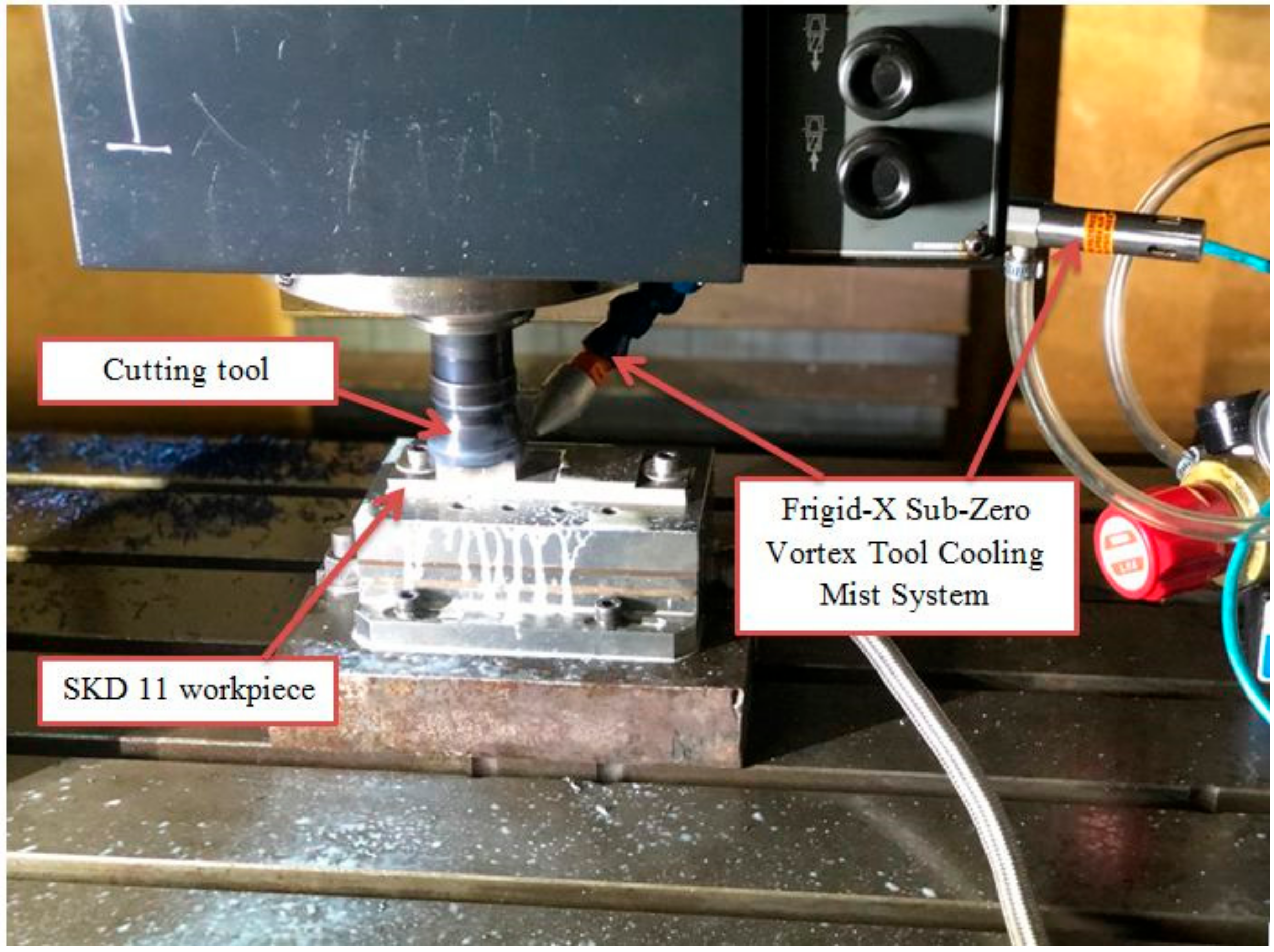
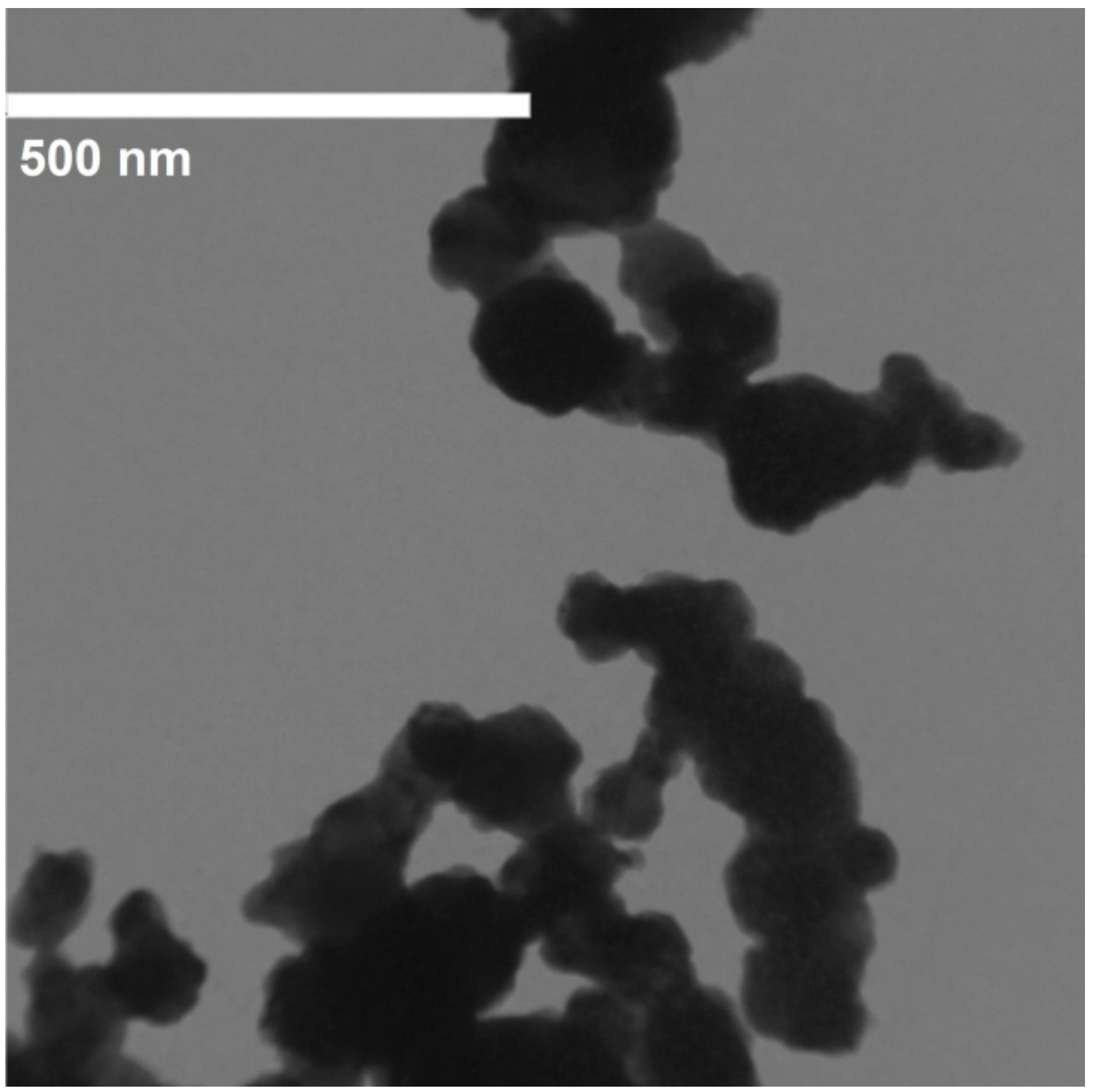
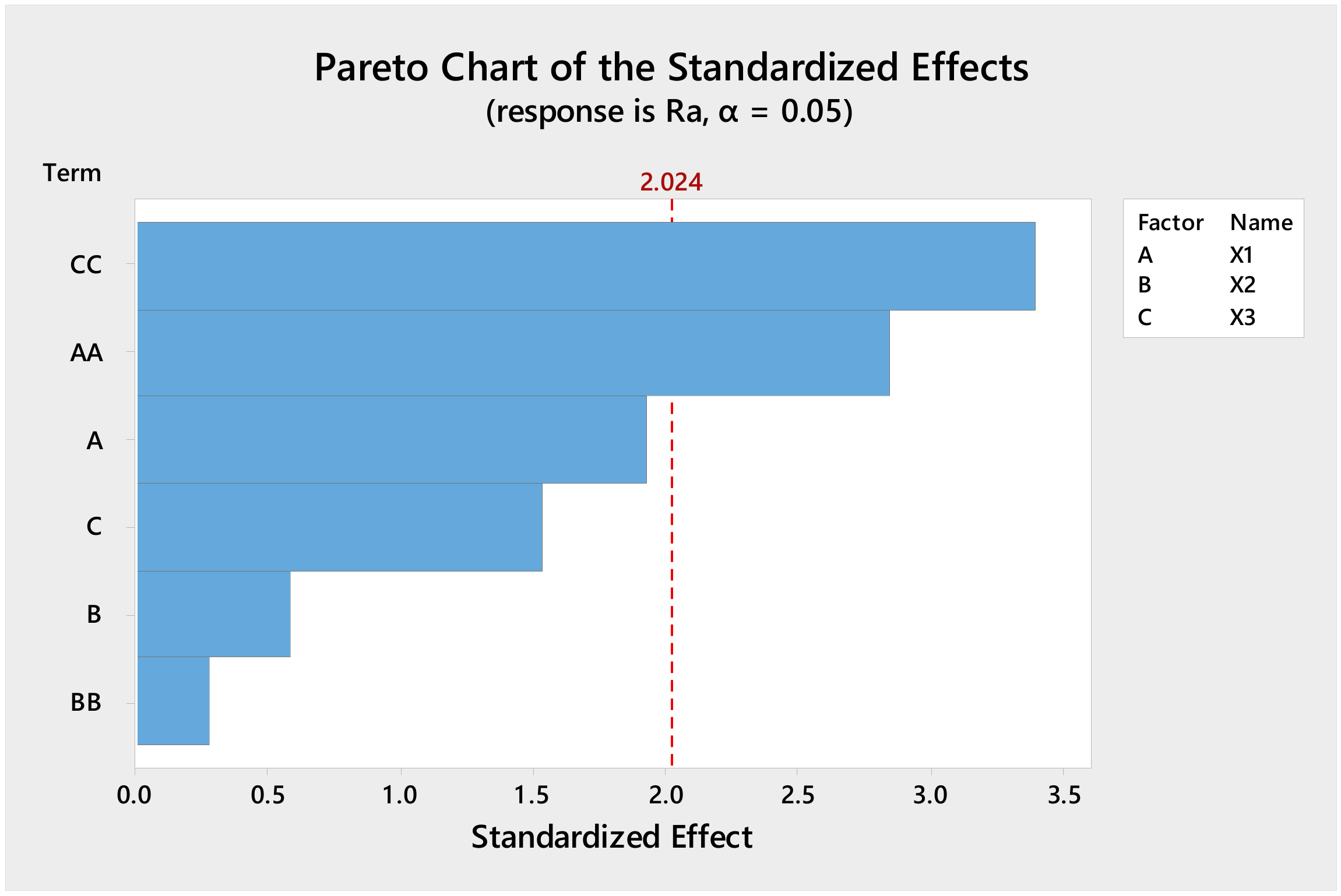
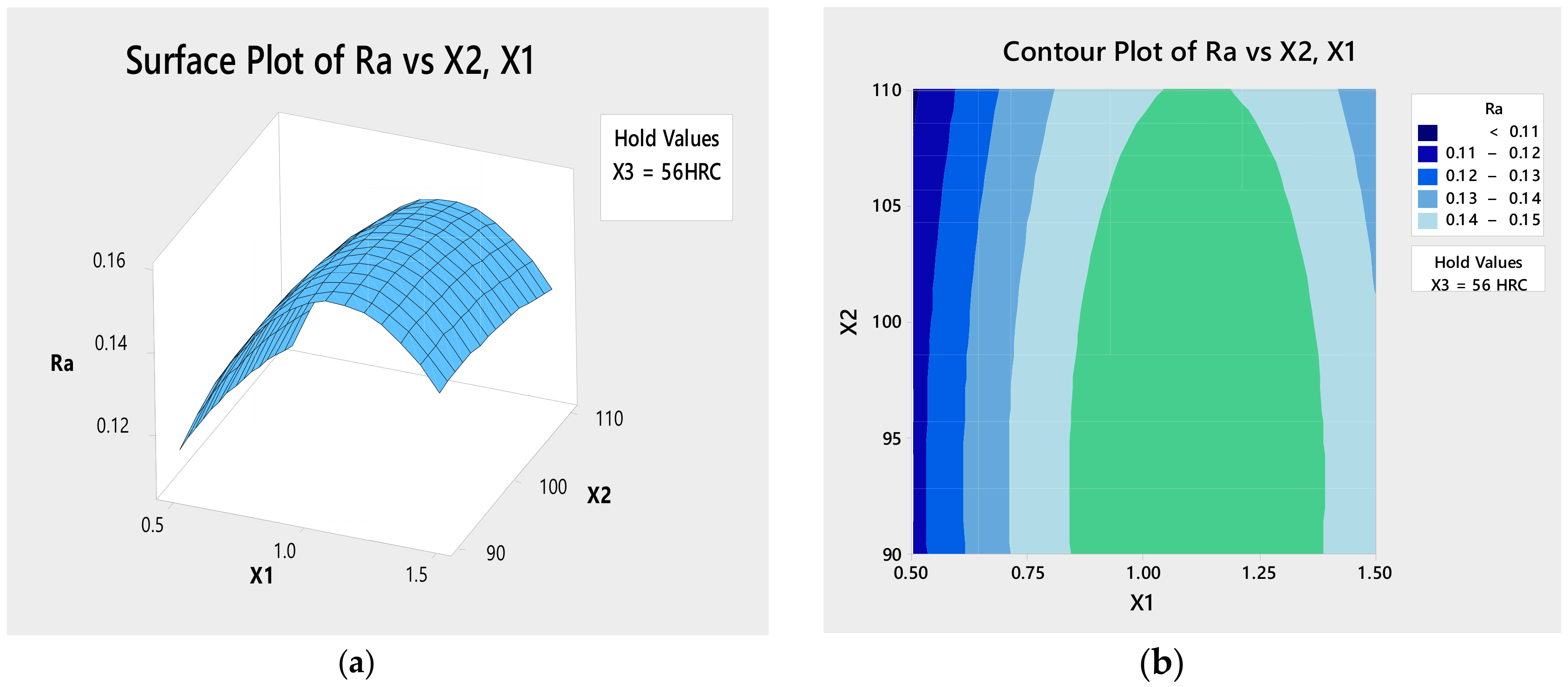
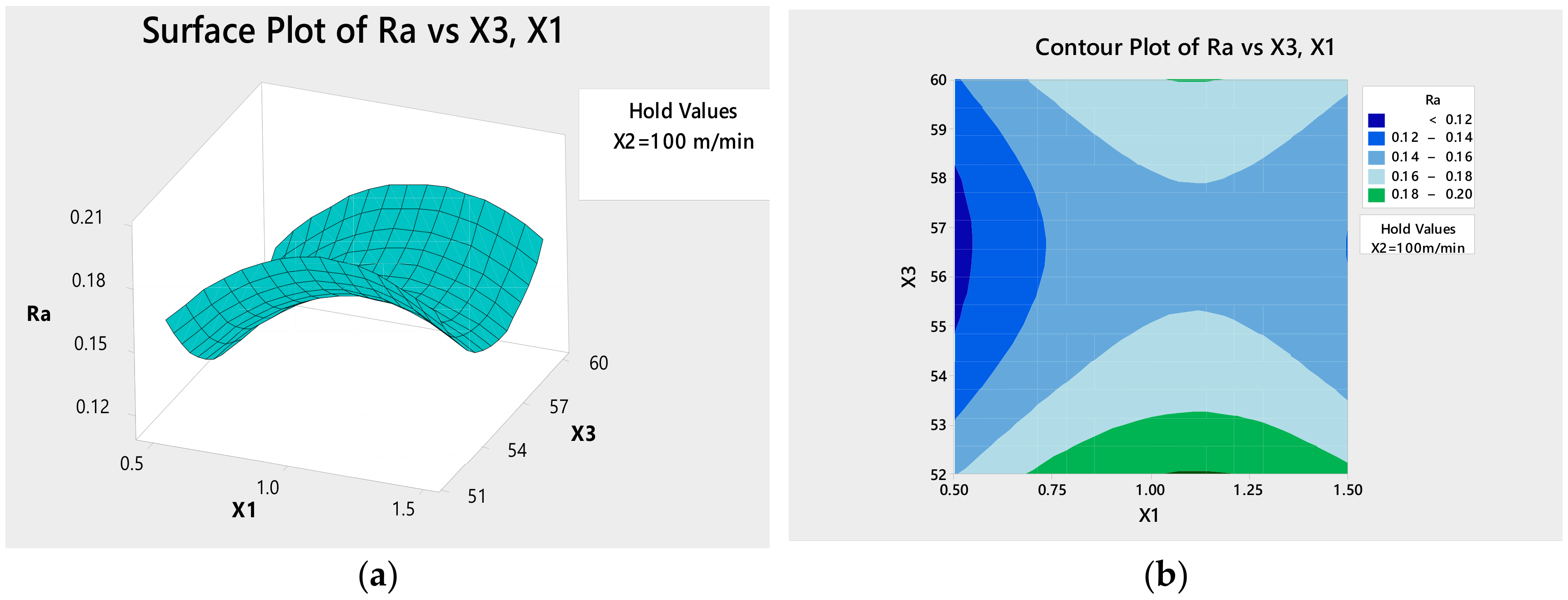
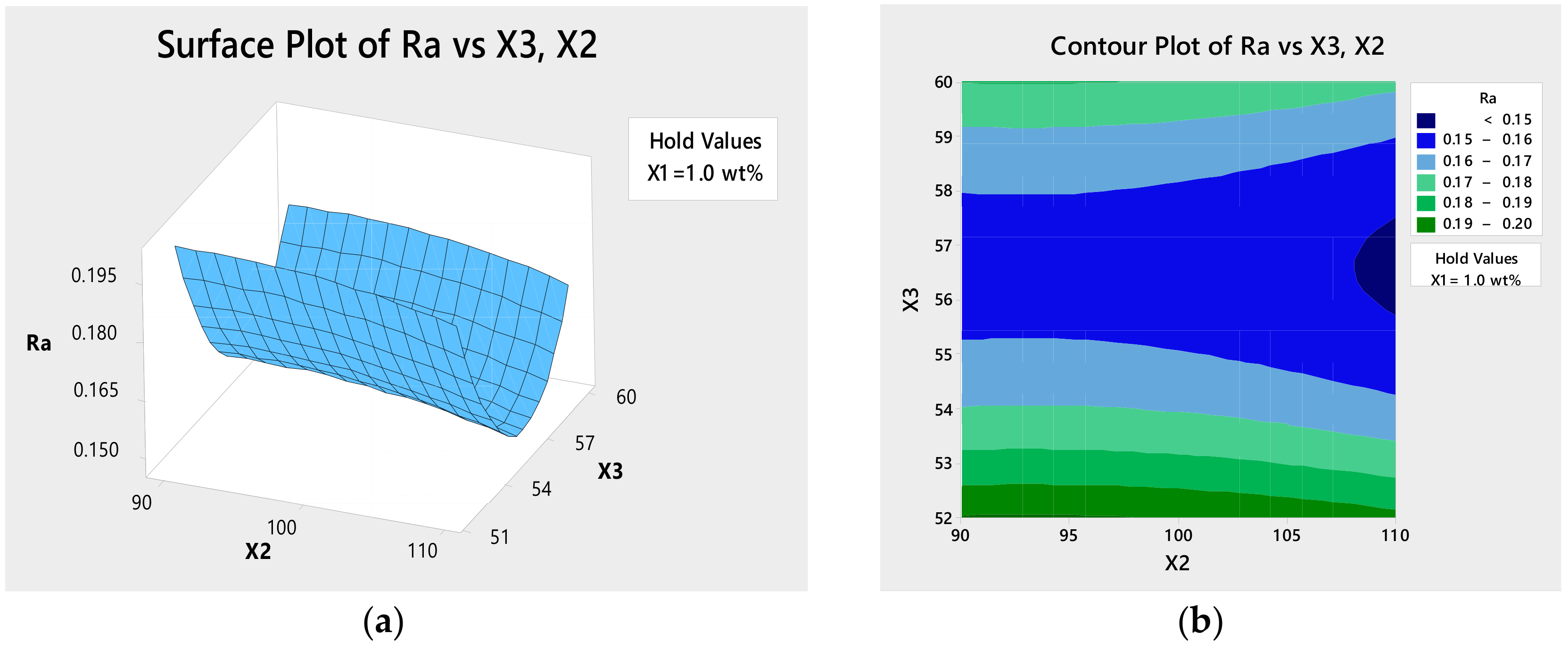
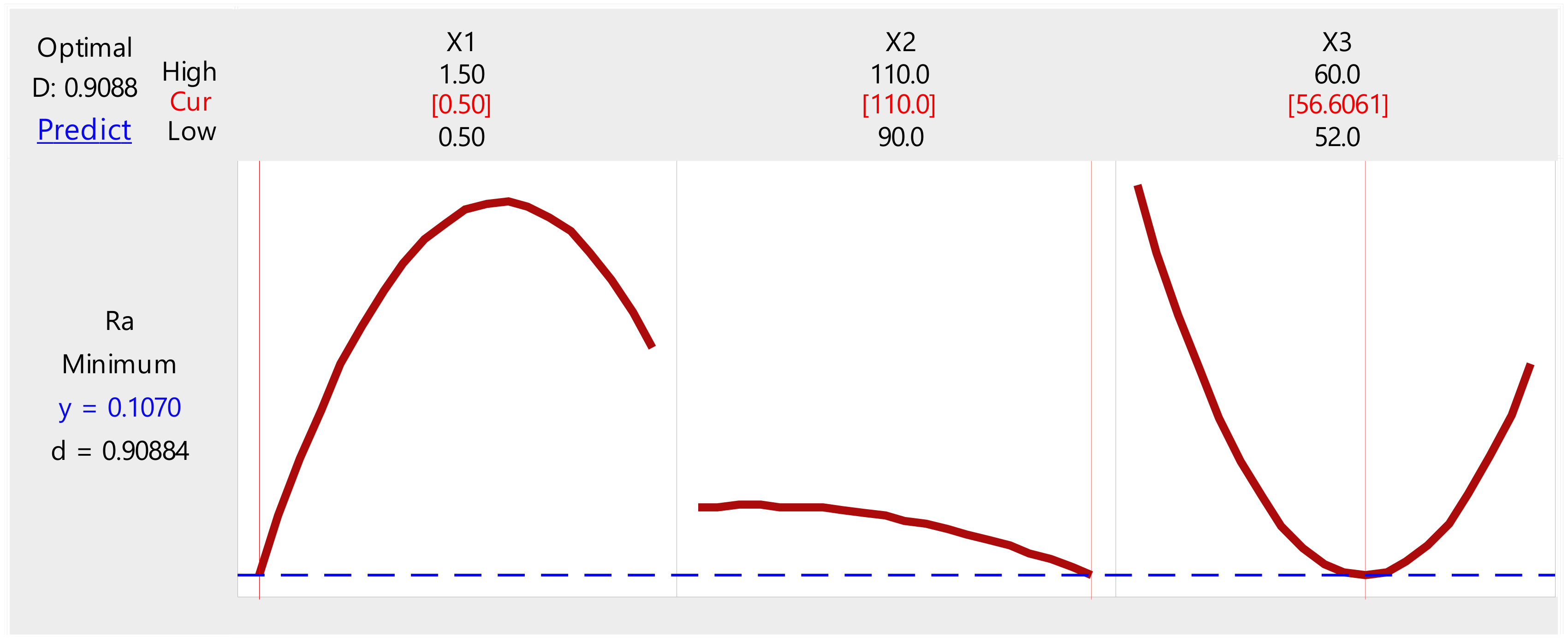
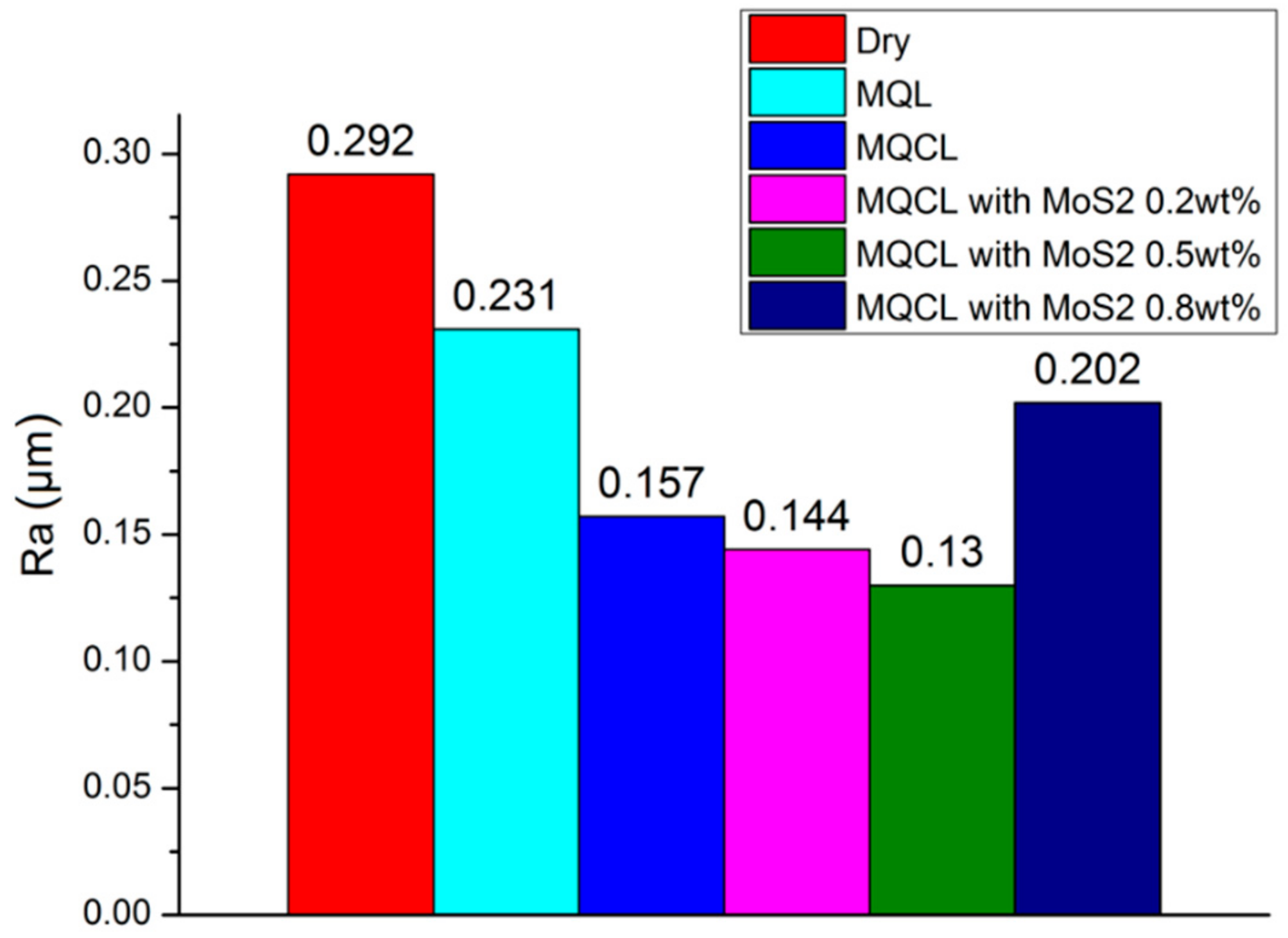
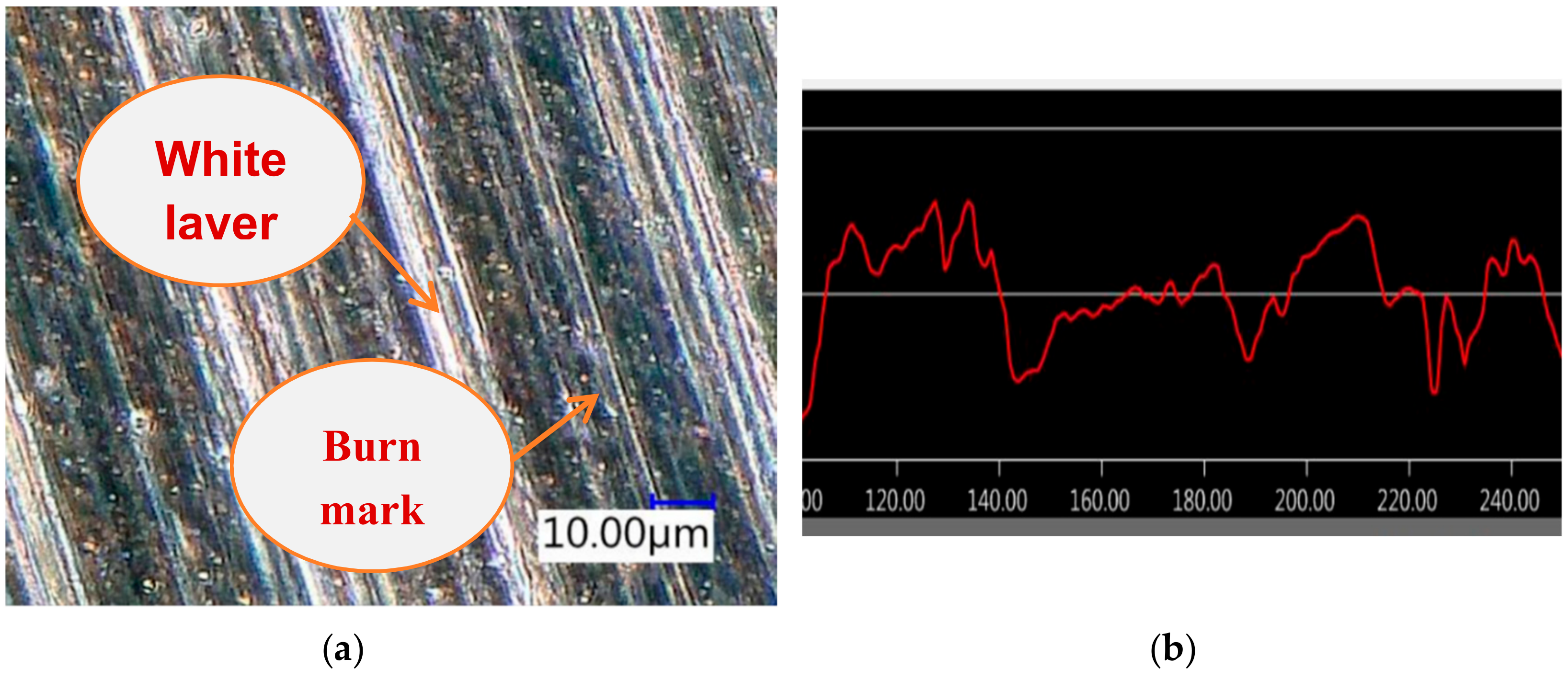
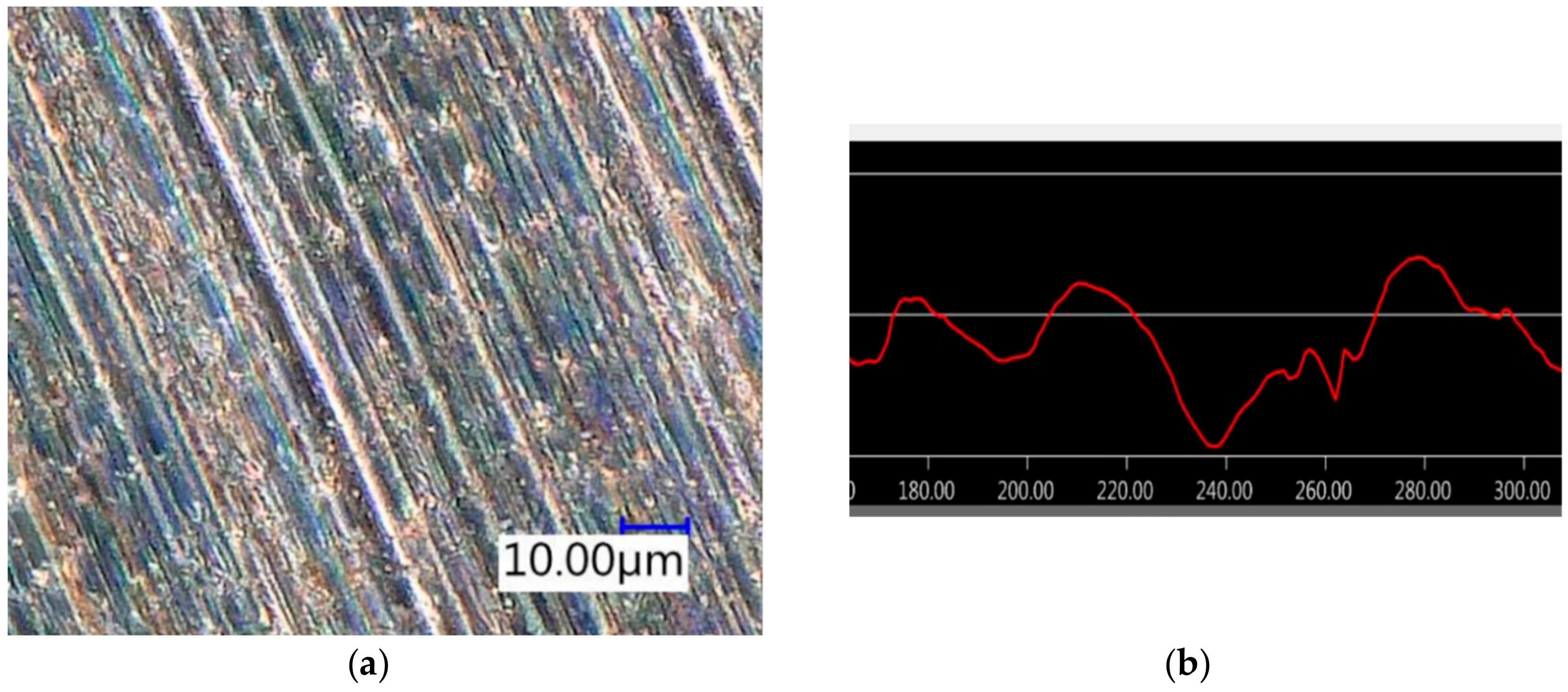

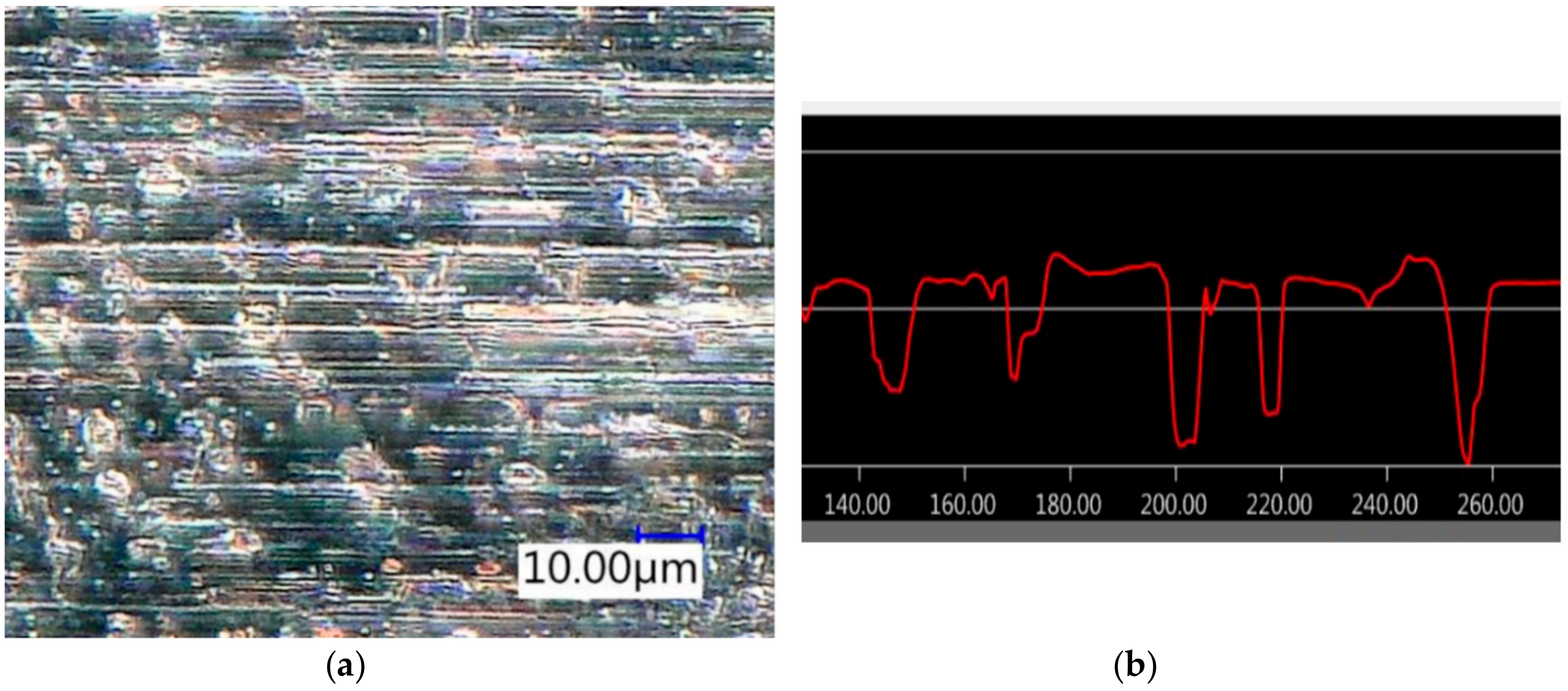
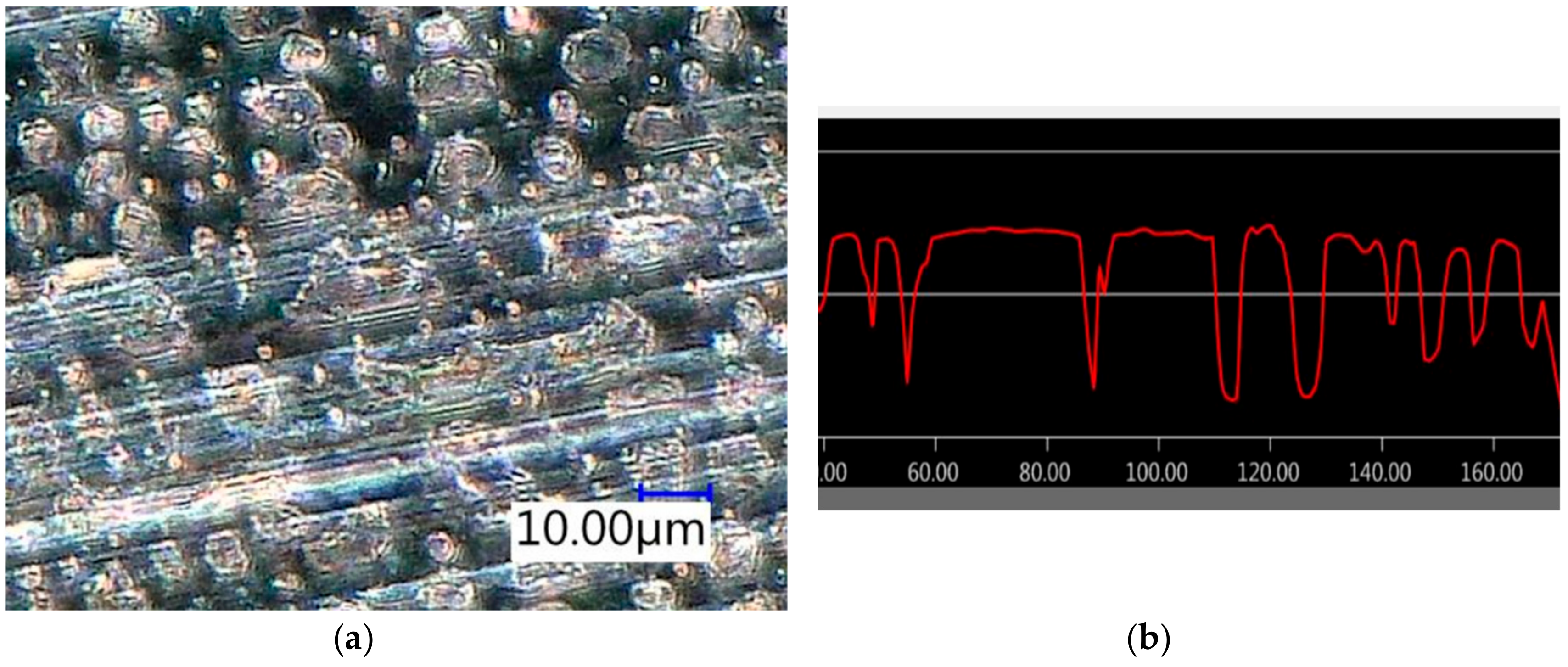
| Chemical Composition (%) | ||||||||||
|---|---|---|---|---|---|---|---|---|---|---|
| C | Si | Mn | Ni | Cr | Mo | W | V | Cu | P | S |
| 1.4–1.6 | 0.4 | 0.6 | 0.5 | 11.0–13.0 | 0.8–1.2 | 0.2–0.5 | ≤0.25 | ≤0.25 | ≤0.03 | ≤0.03 |
| Control Factor | Unit | Symbol | Level | ||
|---|---|---|---|---|---|
| Low | Medium | High | |||
| Nanoparticle concentration (np) | wt% | x1 | 0.5 | 1.0 | 1.5 |
| Cutting speed (Vc) | m/min | x2 | 90 | 100 | 110 |
| Hardness | HRC | x3 | 52 | 56 | 60 |
© 2019 by the authors. Licensee MDPI, Basel, Switzerland. This article is an open access article distributed under the terms and conditions of the Creative Commons Attribution (CC BY) license (http://creativecommons.org/licenses/by/4.0/).
Share and Cite
Dong, P.Q.; Duc, T.M.; Long, T.T. Performance Evaluation of MQCL Hard Milling of SKD 11 Tool Steel Using MoS2 Nanofluid. Metals 2019, 9, 658. https://doi.org/10.3390/met9060658
Dong PQ, Duc TM, Long TT. Performance Evaluation of MQCL Hard Milling of SKD 11 Tool Steel Using MoS2 Nanofluid. Metals. 2019; 9(6):658. https://doi.org/10.3390/met9060658
Chicago/Turabian StyleDong, Pham Quang, Tran Minh Duc, and Tran The Long. 2019. "Performance Evaluation of MQCL Hard Milling of SKD 11 Tool Steel Using MoS2 Nanofluid" Metals 9, no. 6: 658. https://doi.org/10.3390/met9060658
APA StyleDong, P. Q., Duc, T. M., & Long, T. T. (2019). Performance Evaluation of MQCL Hard Milling of SKD 11 Tool Steel Using MoS2 Nanofluid. Metals, 9(6), 658. https://doi.org/10.3390/met9060658






